 As we saw in Part 1, households are seeing a rise in the cost of living, which is set to accelerate. Inflation in the year to January 2022, as measured by the Consumer Prices Index (CPI), was 5.5%, the highest rate for over 30 years, and it is expected to reach more than 7 per cent by April. This has put great pressure on household budgets, with wage rises for most people being below the rate of price inflation. The poor especially have been hard hit, with many struggling to meet soaring energy, food and transport prices and higher rents.
As we saw in Part 1, households are seeing a rise in the cost of living, which is set to accelerate. Inflation in the year to January 2022, as measured by the Consumer Prices Index (CPI), was 5.5%, the highest rate for over 30 years, and it is expected to reach more than 7 per cent by April. This has put great pressure on household budgets, with wage rises for most people being below the rate of price inflation. The poor especially have been hard hit, with many struggling to meet soaring energy, food and transport prices and higher rents.
In Part 2 we look at the UK government’s response to the situation, a similar response to that in many other countries.
Effects on government finances
 The Chancellor, Rishi Sunak, has stated that the government understands the pressures families are facing with the cost of living. However, rising interest rates mean that it will cost the Treasury considerably more to service the UK’s national debt of more than £2tn.
The Chancellor, Rishi Sunak, has stated that the government understands the pressures families are facing with the cost of living. However, rising interest rates mean that it will cost the Treasury considerably more to service the UK’s national debt of more than £2tn.
Interest payments on index-linked debt are calculated using an alternative measure of inflation, the retail prices index (RPI), which is running at 7.8%, considerably higher than anticipated in last October’s Budget. It is now projected that central government spending on debt interest this financial year will come in at around £69bn, some £11bn higher than the £58bn forecast in the October 2021 Budget and £27bn above the £42bn forecast in the March 2021 Budget.
In addition, it is expected that the latest rise in CPI will increase the chances of the Bank of England raising interest rates and thereby further increasing the costs of servicing national debt. If this is the outcome when its Monetary Policy Committee meets next month, then it would be the third successive time interest rates have been raised.
There is also concern that this, in addition to the direct effects of higher costs, will push more firms towards insolvency. It is argued that if government wanted to prevent this, it would need to cut business taxes in order to boost investment and productivity and to allow businesses to provide annual wage rises that are affordable.
Monetary policy
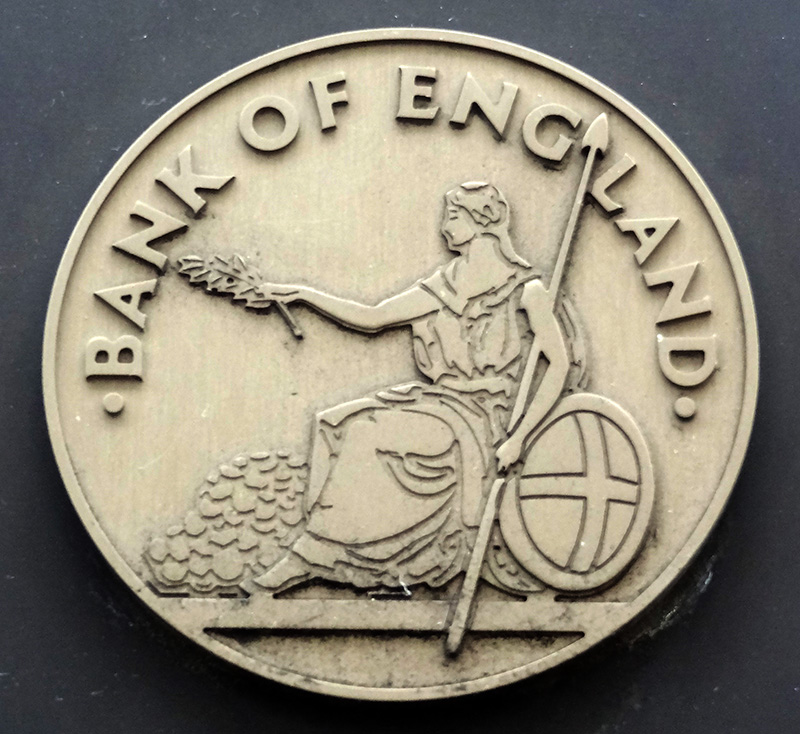 The Bank of England’s traditional response to rising inflation is to raise interest rates, which it has done this twice in the past few months. This means that people who have borrowed money could see their monthly payments go up, especially on mortgages tied to Bank Rate.
The Bank of England’s traditional response to rising inflation is to raise interest rates, which it has done this twice in the past few months. This means that people who have borrowed money could see their monthly payments go up, especially on mortgages tied to Bank Rate.
An aim of this policy is to make borrowing more expensive resulting in people spending less. As a result, they will buy fewer things, and prices will stop rising as fast. However, when inflation is caused by external forces, this might have a limited effect on prices and would put a further squeeze on household budgets.
Fiscal policy
Alternatively, the government might choose to cut taxes for consumers on items whose prices are rising quickly. It is taking some measures to reduce the impact of energy price rises. For example, the Treasury has announced that it would provide millions of households with up to £350 to help with their rising energy bills and in April the lowest-paid will see the National Living Wage rise by 6.6%, which is higher than the current inflation rate.
The chief economist of the British Chambers of Commerce has said that tightening monetary policy too quickly risks undermining confidence and the wider recovery, arguing that more needs to be done to limit the unprecedented rise in costs facing businesses, including financial support for those struggling with soaring energy bills and delaying April’s national insurance rise.
Conclusion
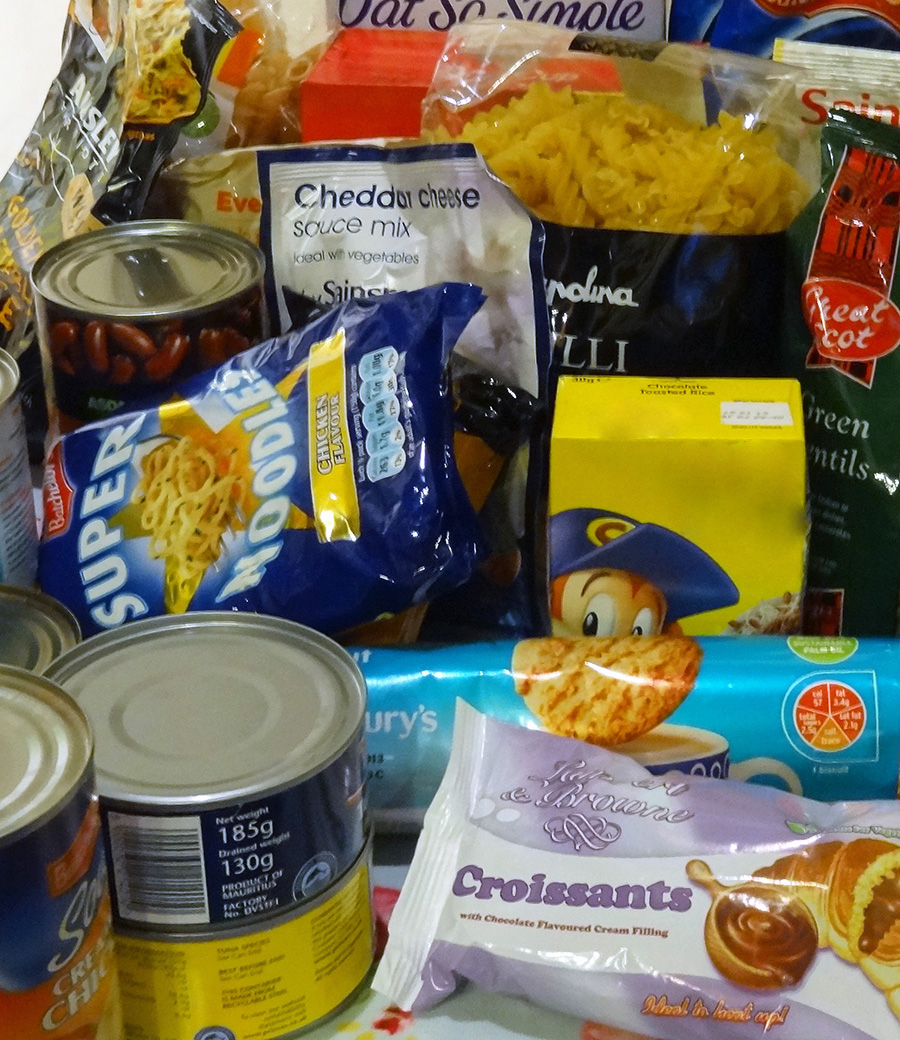 Rising inflation affects all our living standards. It a global issue with causes beyond government control.
Rising inflation affects all our living standards. It a global issue with causes beyond government control.
Rising prices together with planned tax increases mean that real average take-home pay is likely to fall over the coming year. The extra energy costs and tax rises will force families to make savings elsewhere, meaning business revenues may fall, and the economic recovery could be negatively impacted.
However, it is those on low incomes that tend to find it hardest to cope with the rising cost of living. Those impacted the most will be faced with difficult decisions over the coming months as they try to cope with falling real incomes. With food price inflation expected to rise further, a likely rise in interest rates and a further increase in the energy price cap in October, these tough decisions are set to get harder for poorest households in the economy.
Articles
See articles in Part 1
Podcast
Questions
These questions are based on the podcast.
- What elements are there in household energy prices? Which element has gone up most?
- What are the arguments for and against the government delaying the rise in the rate of national insurance by 1.25 percentage points?
- What can be done to help people on modest earnings who earn just too much to receive benefits?
- Are government loans to help people with higher bills a good idea?
- What are the advantages and disadvantages of removing VAT on domestic energy?
 With the onset of the pandemic in early 2020, stock markets around the world fell dramatically, with many indices falling by 30% or more. In the USA, the Dow Jones fell by 37% and the Nasdaq fell by 30%. In the UK, the FTSE 100 fell by 33% and the FTSE 250 by 41%.
With the onset of the pandemic in early 2020, stock markets around the world fell dramatically, with many indices falling by 30% or more. In the USA, the Dow Jones fell by 37% and the Nasdaq fell by 30%. In the UK, the FTSE 100 fell by 33% and the FTSE 250 by 41%.
But with a combination of large-scale government support for their economies, quantitative easing by central banks and returning confidence of investors, stock markets then made a sustained recovery and have continued to grow strongly since – until recently, that is.
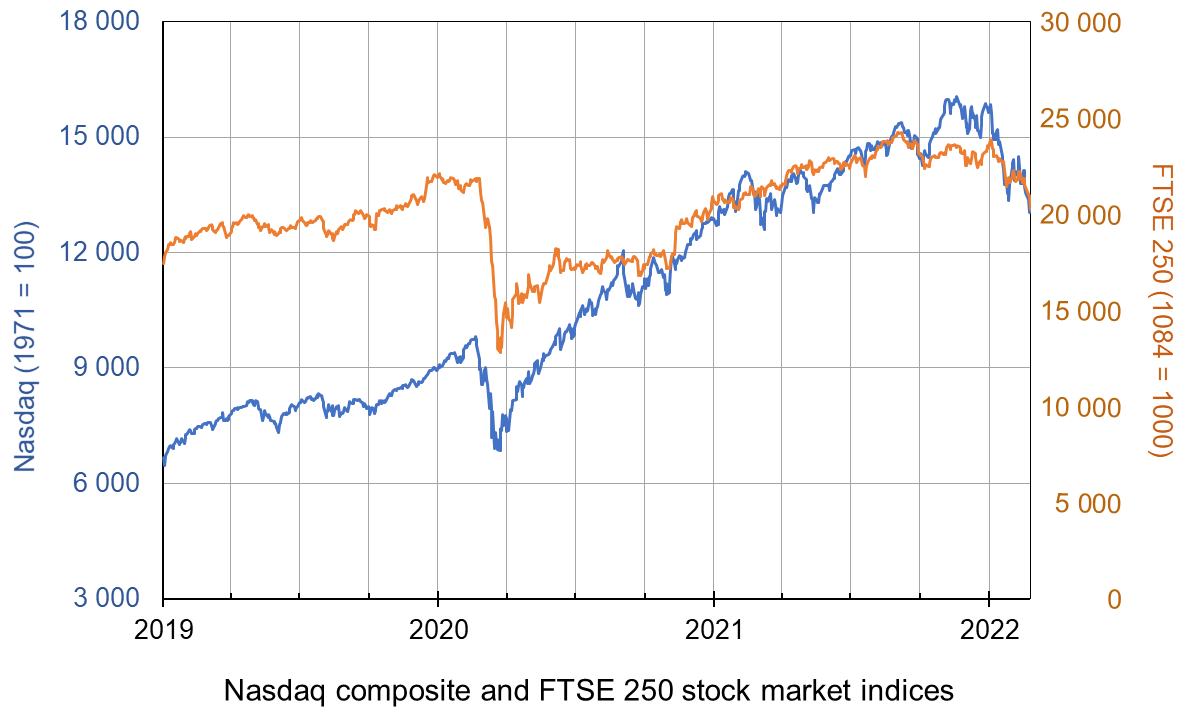
With inflation well above target levels, central banks have ended quantitative easing (QE) or have indicated that they soon will. Interest rates are set to rise, if only slowly. The Bank of England raised Bank Rate from its historic low of 0.1% to 0.25% on 16 December 2021 and ceased QE, having reached its target of £895 billion of asset purchases. On 4 February 2022, it raised Bank Rate to 0.5%. The Fed has announced that it will gradually raise interest rates and will end QE in March 2022, and later in the year could begin selling some of the assets it has purchased (quantitative tightening). The ECB is not ending QE or raising interest rates for the time being, but is likely to do so later in the year.
At the same time economic growth is slowing, leading to fears of stagflation. Governments are likely to dampen growth further by tightening fiscal policy. In the UK, national insurance is set to rise by 1.25 percentage points in April.
The slowdown in growth may discourage central banks from tightening monetary policy more than very slightly. Indeed, in the light of its slowing economy, the Chinese central bank cut interest rates on 20 January 2022. Nevertheless, it is likely that the global trend will be towards tighter monetary policy.
The fears of slowing growth and tighter monetary and fiscal policy have led many stock market investors to predict an end to the rise in stock market prices – an end to the ‘bull run’. This belief was reinforced by growing tensions between Russia and NATO countries and fears (later proved right) that Russia might invade Ukraine with all the turmoil in the global economy that this would entail. Stock market prices have thus fallen.
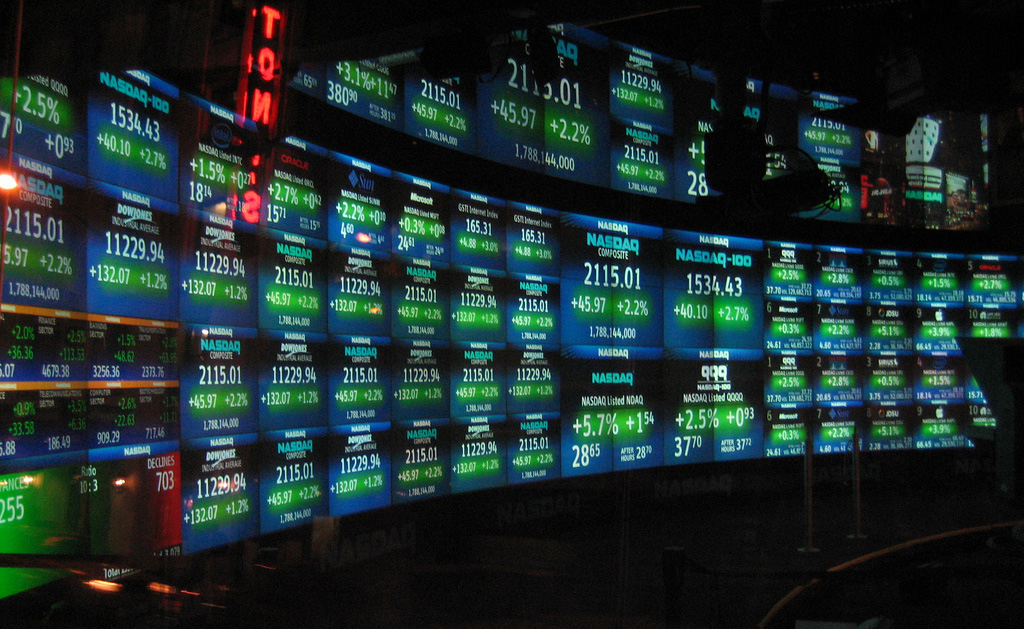 The key question is what will investors believe. If they believe that share prices will continue to fall they are likely to sell. This has happened since early January, especially in the USA and especially with stocks in the high-tech sector – such stocks being heavily represented in the Nasdaq composite, a broad-based index that includes over 2500 of the equities listed on the Nasdaq stock exchange. From 3 January to 18 February the index fell from 15 833 to 13 548, a fall of 14.4%. But will this fall be seen as enough to reflect the current economic and financial climate. If so, it could fluctuate around this sort of level.
The key question is what will investors believe. If they believe that share prices will continue to fall they are likely to sell. This has happened since early January, especially in the USA and especially with stocks in the high-tech sector – such stocks being heavily represented in the Nasdaq composite, a broad-based index that includes over 2500 of the equities listed on the Nasdaq stock exchange. From 3 January to 18 February the index fell from 15 833 to 13 548, a fall of 14.4%. But will this fall be seen as enough to reflect the current economic and financial climate. If so, it could fluctuate around this sort of level.
However, some may speculate that the fall has further to go – that indices are still too high to reflect the earning potential of companies – that the price–earnings ratio is still too high for most shares. If this is the majority view, share prices will indeed fall.
Others may feel that 14.4% is an overcorrection and that the economic climate is not as bleak as first thought and that the Omicron coronavirus variant, being relatively mild for most people, especially if ‘triple jabbed’, may do less economic damage than first feared. In this scenario, especially if the tensions over Ukraine are diffused, people are likely to buy shares while they are temporarily low.
 But a lot of this is second-guessing what other people will do – known as a Keynesian beauty contest situation. If people believe others will buy, they will too and this will push share prices up. If they think others will sell, they will too and this will push share prices down. They will all desperately wish they had a crystal ball as they speculate how people will interpret what central banks, governments and other investors will do.
But a lot of this is second-guessing what other people will do – known as a Keynesian beauty contest situation. If people believe others will buy, they will too and this will push share prices up. If they think others will sell, they will too and this will push share prices down. They will all desperately wish they had a crystal ball as they speculate how people will interpret what central banks, governments and other investors will do.
Articles
Questions
- What changes in real-world factors would drive investors to (a) buy (b) sell shares at the current time?
- How does quantitative easing affect share prices?
- What is meant by the price-earnings ratio of a share? Is it a good indicator as to the likely movement of that share’s price? Explain.
- What is meant by a Keynesian beauty contest? How is it relevant to the stock market?
- Distinguish between stabilising and destabilising speculation and illustrate each with a demand and supply diagram. Explain the concept of overshooting in this context.
- Which is more volatile, the FTSE 100 or the FTSE 250? Explain.
- Read the final article linked above. Were the article’s predictions about the Fed meeting on 26 January borne out? Comment.
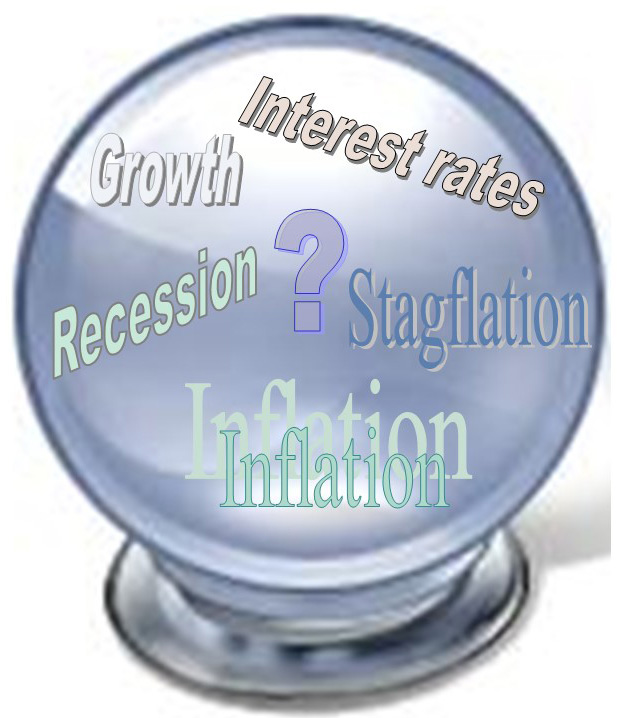 Inflation across the world has been rising. This has been caused by a rise in aggregate demand as the global economy has ‘bounced back’ from the pandemic, while supply-chain disruptions and tight labour markets constrain the ability of aggregate supply to respond to the rise in demand.
Inflation across the world has been rising. This has been caused by a rise in aggregate demand as the global economy has ‘bounced back’ from the pandemic, while supply-chain disruptions and tight labour markets constrain the ability of aggregate supply to respond to the rise in demand.
But what of the coming months? Will supply become more able to respond to demand as supply-chain issues ease, allowing further economic growth and an easing of inflationary pressures?
Or will higher inflation and higher taxes dampen real demand and cause growth, or even output, to fall? Are we about to enter an era of ‘stagflation’, where economies experience rising inflation and economic stagnation? And will stagnation be made worse by central banks which raise interest rates to dampen the inflation but, in the process, dampen spending.
Despite the worries of central banks, with inflation being higher than forecast a few months ago, forecasts (e.g. the OECD’s) are still for inflation to peak fairly soon and then to fall back to around 2 to 3 per cent by the beginning of 2023 – close to central bank target rates.
 In the UK, annual CPI inflation reached 5.4% in December 2021. The UK Treasury’s January 2022 new monthly forecasts for the UK economy by 15 independent institutions give an average forecast of 4.0% for CPI inflation for 2022. In the USA, annual consumer price inflation reached 7 per cent in December 2021, but is forecast to fall to just over the target rate of 2% by the end of 2022.
In the UK, annual CPI inflation reached 5.4% in December 2021. The UK Treasury’s January 2022 new monthly forecasts for the UK economy by 15 independent institutions give an average forecast of 4.0% for CPI inflation for 2022. In the USA, annual consumer price inflation reached 7 per cent in December 2021, but is forecast to fall to just over the target rate of 2% by the end of 2022.
If central banks respond to the current high inflation by raising interest rates more than very slightly and by stopping quantitative easing (QE), or even engaging in quantitative tightening (selling assets purchased under previous QE schemes), there is a severe risk of a sharp slowdown in economic activity. Household budgets are already being squeezed by the higher prices, especially energy and food prices. And people will face higher taxes as governments seek to reduce their debts, which soared with the Covid support packages during the pandemic.
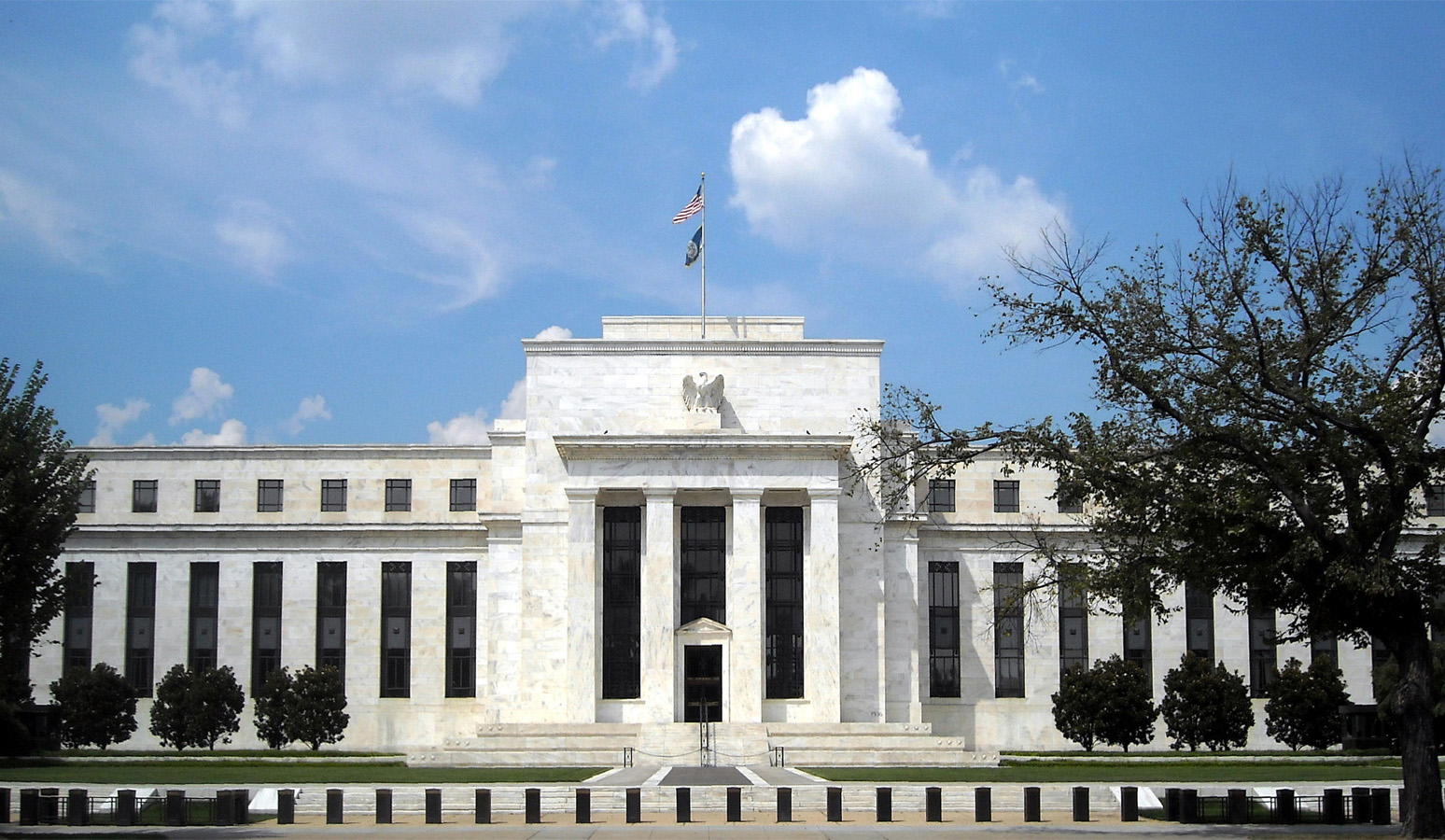 The Fed has signalled that it will end its bond buying (QE) programme in March 2022 and may well raise interest rates at the same time. Quantitative tightening may then follow. But although GDP growth is still strong in the USA, Fed policy and stretched household budgets could well see spending slow and growth fall. Stagflation is less likely in the USA than in the UK and many other countries, but there is still the danger of over-reaction by the Fed given the predicted fall in inflation.
The Fed has signalled that it will end its bond buying (QE) programme in March 2022 and may well raise interest rates at the same time. Quantitative tightening may then follow. But although GDP growth is still strong in the USA, Fed policy and stretched household budgets could well see spending slow and growth fall. Stagflation is less likely in the USA than in the UK and many other countries, but there is still the danger of over-reaction by the Fed given the predicted fall in inflation.
But there are reasons to be confident that stagflation can be avoided. Supply-chain bottlenecks are likely to ease and are already showing signs of doing so, with manufacturing production recovering and hold-ups at docks easing. The danger may increasingly become one of demand being excessively dampened rather than supply being constrained. Under these circumstances, inflation could rapidly fall, as is being forecast.
Nevertheless, as Covid restrictions ease, the hospitality and leisure sector is likely to see a resurgence in demand, despite stagnant or falling real disposable incomes, and here there are supply constraints in the form of staffing shortages. This could well lead to higher wages and prices in the sector, but probably not enough to prevent the fall in inflation.
Articles
- Inflation will probably melt away in 2022 – central banks will do far more harm trying to tackle it
The Conversation, Brigitte Granville (14/1/22)
- Stagflation and why it matters
The Week, Chas Newkey-Burden (1/10/21)
- Surging inflation could dwarf other issues in the political landscape as households feel the strain
Sky News, Ed Conway (19/1/22)
- Inflation is back, and there’s plenty more in the pipeline
The Guardian, Larry Elliott (19/1/22)
- UK inflation jumps to highest level in 30 years
Financial Times, Chris Giles (19/1/22)
- UK workers’ pay rises fall behind inflation amid cost-of-living crisis
The Guardian, Richard Partington (18/1/22)
- UK faces a pay squeeze – and higher interest rates look likely
The Guardian, Phillip Inman (18/1/22)
- Inflation: why it’s temporary and raising interest rates will do more harm than good
The Conversation, Muhammad Ali Nasir (22/11/21)
- Inflation: why it is the biggest test yet for central bank independence
The Conversation, Anton Muscatelli (14/12/21)
- Three more interest rate rises loom after Bank’s borrowing cost shock
The Telegraph, Russell Lynch and Tim Wallace (16/12/21)
- US Stagflation: The Global Risk Of 2022 – OpEd
Eurasia Review, Dan Steinbock (17/1/22)
- If prices keep rising, a nightmare scenario for the US economy is a real possibility
CNN, Paul R La Monica (12/1/22)
- Will inflation in the UK keep rising?
Bank of England (10/12/21)
Data
Questions
- Under what circumstances would stagflation be (a) more likely; (b) less likely?
- Find out the causes of stagflation in the early/mid-1970s.
- Argue the case for and against the Fed raising interest rates and ending its asset buying programme.
- Why are labour shortages likely to be higher in the UK than in many other countries?
- Research what is likely to happen to fuel prices over the next two years. How is this likely to impact on inflation and economic growth?
- Is the rise in prices likely to increase or decrease real wage inequality? Explain.
- Distinguish between cost-push and demand-pull inflation. Which of the two is more likely to result in stagflation?
- Why are inflationary expectations a major determinant of actual inflation? What influences inflationary expectations?
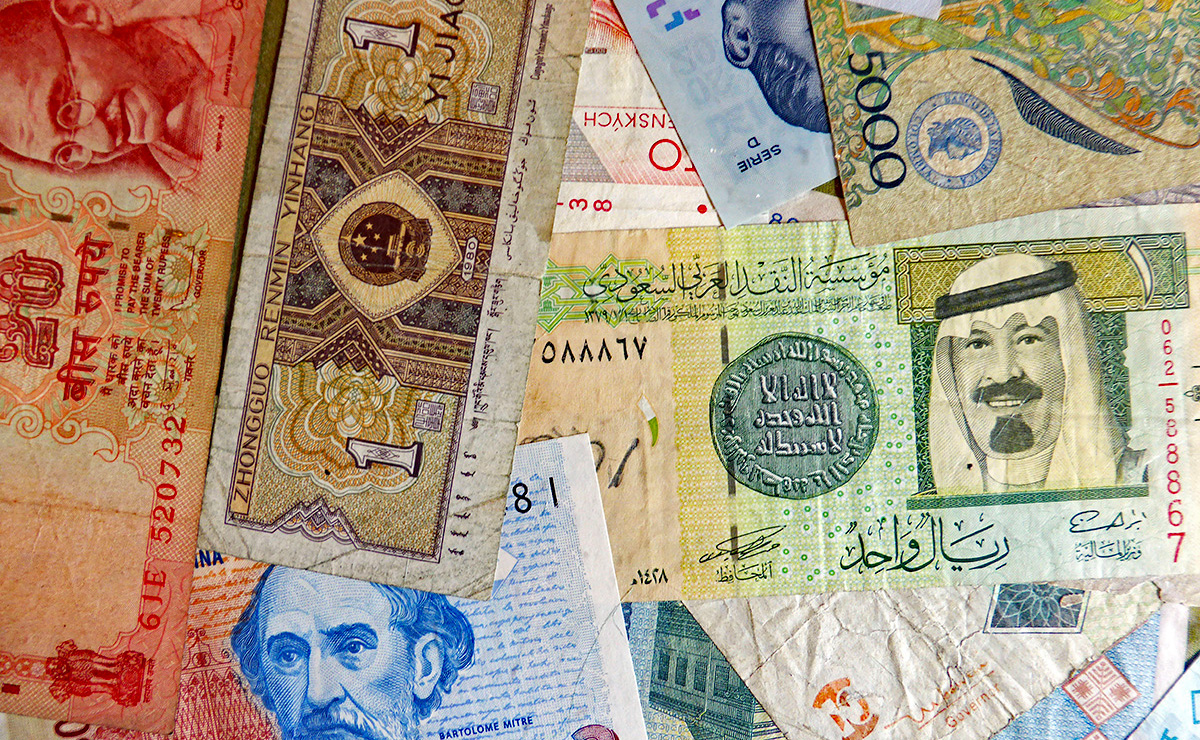 Inflation has been rising around the world as a combination of a recovery in demand and supply-chain issues have resulted in aggregate demand exceeding aggregate supply. Annual consumer price inflation at the beginning of 2022 is around 2.5% in China, 3.5% in Sweden, 5% in the eurozone, Canada and India, 6% in the UK and South Africa, 7% in the USA and 7.5% in Mexico. In each case it is forecast to go a little higher before falling back again.
Inflation has been rising around the world as a combination of a recovery in demand and supply-chain issues have resulted in aggregate demand exceeding aggregate supply. Annual consumer price inflation at the beginning of 2022 is around 2.5% in China, 3.5% in Sweden, 5% in the eurozone, Canada and India, 6% in the UK and South Africa, 7% in the USA and 7.5% in Mexico. In each case it is forecast to go a little higher before falling back again.
Inflation in Turkey
In Turkey inflation is much higher. The official annual rate of consumer price inflation in December 2021 was 36.1%, sharply up from 21.3% in November. But according to Turkey’s influential ENAGrup the December rate was much higher still at 82.8%. Official producer price inflation was 79.9% and this will feed through into official consumer price inflation in the coming weeks.
The rise in inflation has hit the poor particularly badly. According to the official statistics, in the year to December 2021, domestic energy prices increased by 34.2%, food by 44.7% and transport by 53.7%. In response, the government has raised the minimum wage by nearly 50% for 2022.
Causes of high and rising inflation
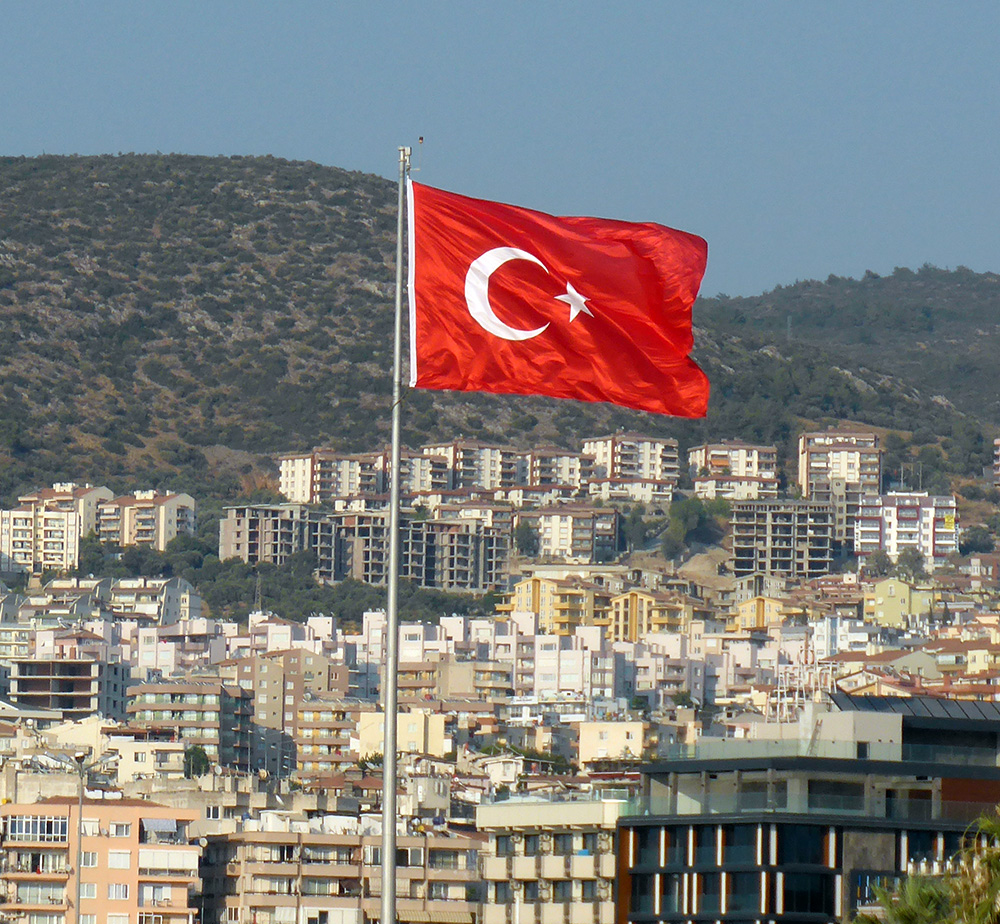 Why is Turkey’s inflation so much higher than in most developed and emerging economies and why has it risen so rapidly? The answer is that aggregate demand has been excessively boosted – well ahead of the ability of supply to respond. This has driven inflation expectations.
Why is Turkey’s inflation so much higher than in most developed and emerging economies and why has it risen so rapidly? The answer is that aggregate demand has been excessively boosted – well ahead of the ability of supply to respond. This has driven inflation expectations.
Turkey’s leader, President Erdoğan, in recent years has been seeking to stimulate economic growth through a mixture of supply-side, fiscal and monetary policies. He has hoped that the prospect of high growth would encourage both domestic and inward investment and that this would indeed drive the high growth he seeks. To encourage investment he has sought to reduce the reliance on imports through various measures, such as public procurement favouring domestic firms, tax reliefs for business and keeping interest rates down. He has claimed that the policy is focused on investment, production, employment and exports, instead of the ‘vicious circle of high interest rates and low exchange rates’.
With the pandemic, fiscal policy was largely focused on health, social security and employment measures. Such support was aided by a relatively healthy public finances. General government debt was 32% of GDP in 2020. This compares with 74% for the EU and 102% for the G7. Nevertheless, the worsening budget deficit has made future large-scale expenditure on public infrastructure, tax cuts for private business and other supply-side measures more difficult. Support for growth has thus fallen increasingly to monetary policy.
The Turkish central bank is not independent, with the President firing senior officials with whom he disagrees over monetary policy. The same applies to the Finance Ministry, with independently-minded ministers losing their jobs. Monetary and exchange rate policy have thus become the policy of the President. And it is here that a major part of the current problem of rising inflation lies.
Monetary and exchange rate policy
Despite rising inflation, the central bank has reduced interest rates. At its monthly meeting in September 2021, the Turkish central bank reduced its key rate from 19% to 18% and then to 16% in October, to 15% in November and 14% in December. These unprecedented rate cuts saw a large increase in the money supply. M1 rose by 11.7% in November alone; the annual growth rate was 59.5%. Broad money (M2 and M3) similarly rose. M3 grew by an annual rate of 51% in November 2021. The cut in interest rates and rise in money supply led to a rise in nominal expenditure which, in turn, led to higher prices.
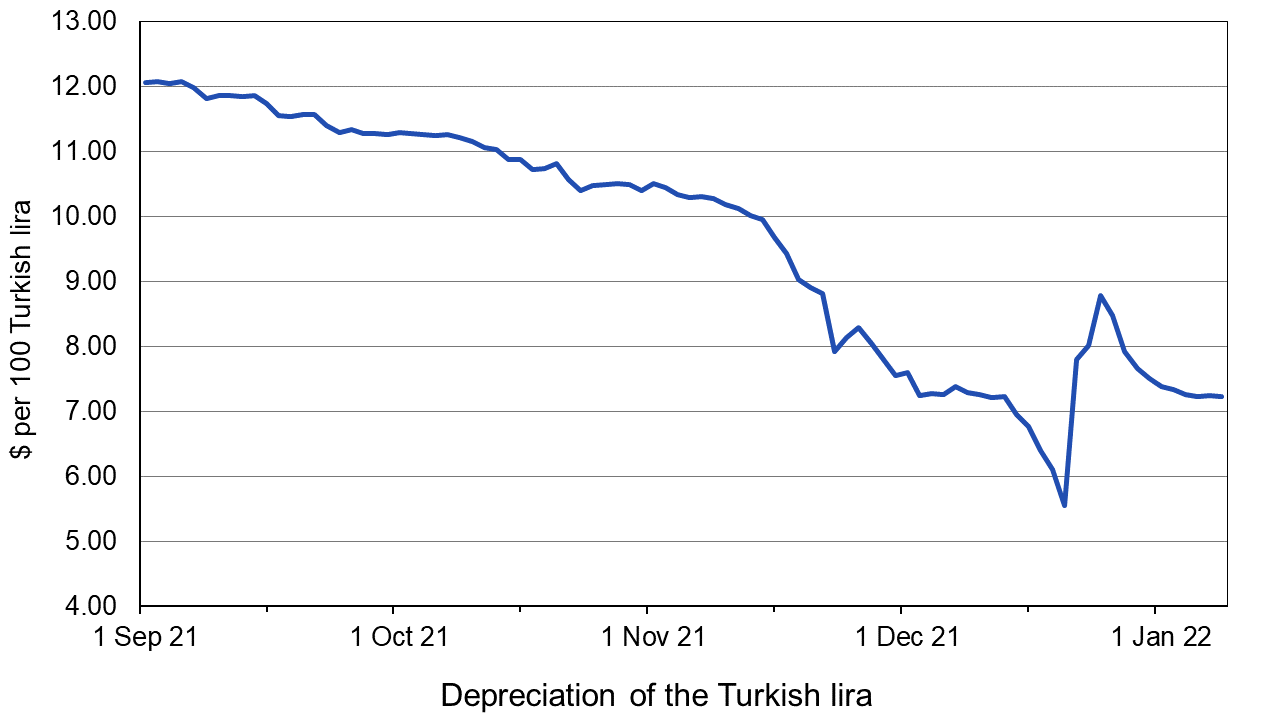
The cut in interest rates and rise in nominal aggregate demand led to a large depreciation in the exchange rate. On 1 September 2021, 100 Turkish lira exchanged for $12.05. By 11 January 2022 the rate had fallen to $7.22 – a 40.1% depreciation. This depreciation, in turn, further stoked inflation as the lower exchange rate pushed up the price of imported goods. (Click here for a PowerPoint of the chart.)
Attempts were made to stem this fall in the lira on 20 December, by which point 100 lira were trading for just $5.50 (see chart) and speculation against the lira was gathering momentum. President Erdoğan announced a scheme to protect lira deposits against currency volatility, guaranteeing lira deposits in hard currency terms. The mechanism adopted was a rise in the interest rate on lira deposits with a maturity of 3 to 12 months, thereby encouraging people to lock in deposits for the medium term and not, therefore, to use them to speculate against the lira by buying other currencies. Other interest rates would be unaffected. At the same time the central bank used foreign currency reserves to engage in large-scale purchases of the lira on the foreign exchange market.
The lira rallied. By 23 December, 100 lira were trading for $8.79. But then selling of the lira began again and, as stated above, by early January 100 lira had fallen to $7.22. The underlying problem of excess demand and high inflationary expectations had not been solved.
It remains to be seen whether the President will change his mind and decide that the central bank needs to raise interest rates to reduce inflation and restore confidence.
Videos
Articles
- Turkish Inflation Hits Highest Since 2002 Amid Lira Woes
Bloomberg, Baris Balci and Cagan Koc (3/1/22)
- Turkey’s annual inflation rate is over 82 percent, finds research group
Bianet (3/1/22)
- How Turkey can overcome its economic challenges
Arab News, Zaid M Belbagi (2/1/22)
- Turkey cuts interest rates despite spiralling inflation
BBC News, Victoria Craig (16/12/21)
- Turkey inflation surges 36% amid lira crisis, highest since 2002
CNBC (3/1/22)
- Turkey mulls new financial instruments to shield against inflation
Daily Sabah (3/1/22)
- Turkey raises minimum wage as lira crash, inflation sow hardship
Aljazeera, Umar Farooq (16/12/21)
- What to make of Turkey’s latest unorthodox currency move
Financial Times, Mohamed El-Erian (21/12/21)
- Erdoğan gambles on economy amid protests and rocketing inflation
The Guardian, Phillip Inman (24/11/21)
- Explained: How did Turkey’s economy go so wrong?
The Indian Express, Patricia Cohen (15/12/21)
Data
Questions
- Until the pandemic, the Turkish economy could be seen as a success story. Why?
- What supply-side policies did Turkey pursue?
- Use either an aggregate demand and supply diagram or a dynamic aggregate demand and supply (DAD/DAS) diagram to explain what has happened to inflation in Turkey in the past few months.
- Explain the thinking behind the successive cuts in interest rates since September 2021.
- Why did the measures introduced on 20 December 2021 only temporarily halt the depreciation of the lira?
- Choose a country with a higher rate of inflation than Turkey (see second data link above). Find out the causes of its high rate. Are they similar to those in Turkey?
 Inflation has surged worldwide as countries have come out of their COVID-19 lockdowns. The increases in prices combined with supply-chain problems has raised questions of what will happen to future prices and whether it will feed further inflation cycles.
Inflation has surged worldwide as countries have come out of their COVID-19 lockdowns. The increases in prices combined with supply-chain problems has raised questions of what will happen to future prices and whether it will feed further inflation cycles.
Inflation targeting
Inflation is a key contributor to instability in an economy. It measures the rate of increases in prices over a given period of time and indicates what will happen to the cost of living for households. Because of its importance, many central banks aim to keep inflation low and steady by setting a target. The Bank of England, the Federal Reserve, and the European Central Bank all aim to keep inflation low at a target rate of 2 per cent.
Inflation-rate targeting has been successfully practised in a growing number of countries over the past few decades. However, measures to combat rising inflation typically contract the economy through reducing real aggregate demand (or at least its rate of growth). This is a concern when the economy is not experiencing a strong economic performance.
Current outlook
 Globally, rising inflation is causing concern as a surge in demand has been confronted by supply bottlenecks and rising prices of energy and raw materials. As the world emerges from the COVID-19 lockdowns, global financial markets have been affected in recent months by concerns around inflation. They have also been affected by the prospect of major central banks around the world being forced into the early removal of pandemic support measures, such as quantitative easing, before the economic recovery from the coronavirus is complete.
Globally, rising inflation is causing concern as a surge in demand has been confronted by supply bottlenecks and rising prices of energy and raw materials. As the world emerges from the COVID-19 lockdowns, global financial markets have been affected in recent months by concerns around inflation. They have also been affected by the prospect of major central banks around the world being forced into the early removal of pandemic support measures, such as quantitative easing, before the economic recovery from the coronavirus is complete.
The Chief Economist at the Bank of England has warned that UK inflation is likely to rise ‘close to or even slightly above 5 per cent’ early next year, as he said the central bank would have a ‘live’ decision on whether to raise interest rates at its November meeting. Although consumer price inflation dipped to 3.1 per cent in September, the Bank of England has forecast it to exceed 4 per cent by the end of the year, 2 percentage points higher than its target. UK banks and building societies have already started to increase mortgage rates in response to rising inflation, signalling an end to the era of ultra-low borrowing costs and piling further pressure on household finances.
In the USA, shortages throughout the supply chains on which corporate America depends are also causing concern. These issues are translating into widespread inflationary pressure, disrupting operations and forcing companies to raise prices for customers. Pressure on every link in the supply chain, from factory closures triggered by COVID-19 outbreaks to trouble finding enough staff to unload trucks, is rippling across sectors, intensifying questions about the threat that inflation poses to robust consumer spending and rebounding corporate earnings. Reflecting concern over weaker levels of global economic growth despite rising inflationary pressures, US figures published at the end of October showed the world’s largest economy added just 194 000 jobs in September, far fewer than expected.
There are also fears raised over high levels of corporate debt, including in China at the embattled property developer Evergrande, where worries over its ability to keep up with debt payments have rippled through global markets. There are major concerns that Evergrande could pose risks to the wider property sector, with potential spill-overs internationally. However, it is argued that the British banking system has been shown in stress tests to be resilient to a severe economic downturn in China and Hong Kong.
Central bank responses
The sharpest consumer-price increases in years have evoked different responses from central banks. Many have raised interest rates, but two that haven’t are the most prominent in the global economy: the Federal Reserve and the European Central Bank. These differences in responses reflect differing opinions as to whether current price increases will feed further inflation cycles or simply peter out. For those large central banks, they are somewhat relying on households keeping faith in their track record of keeping inflation low. There is also an expectation that there are enough underutilised workers to ensure that wage inflation is kept low.
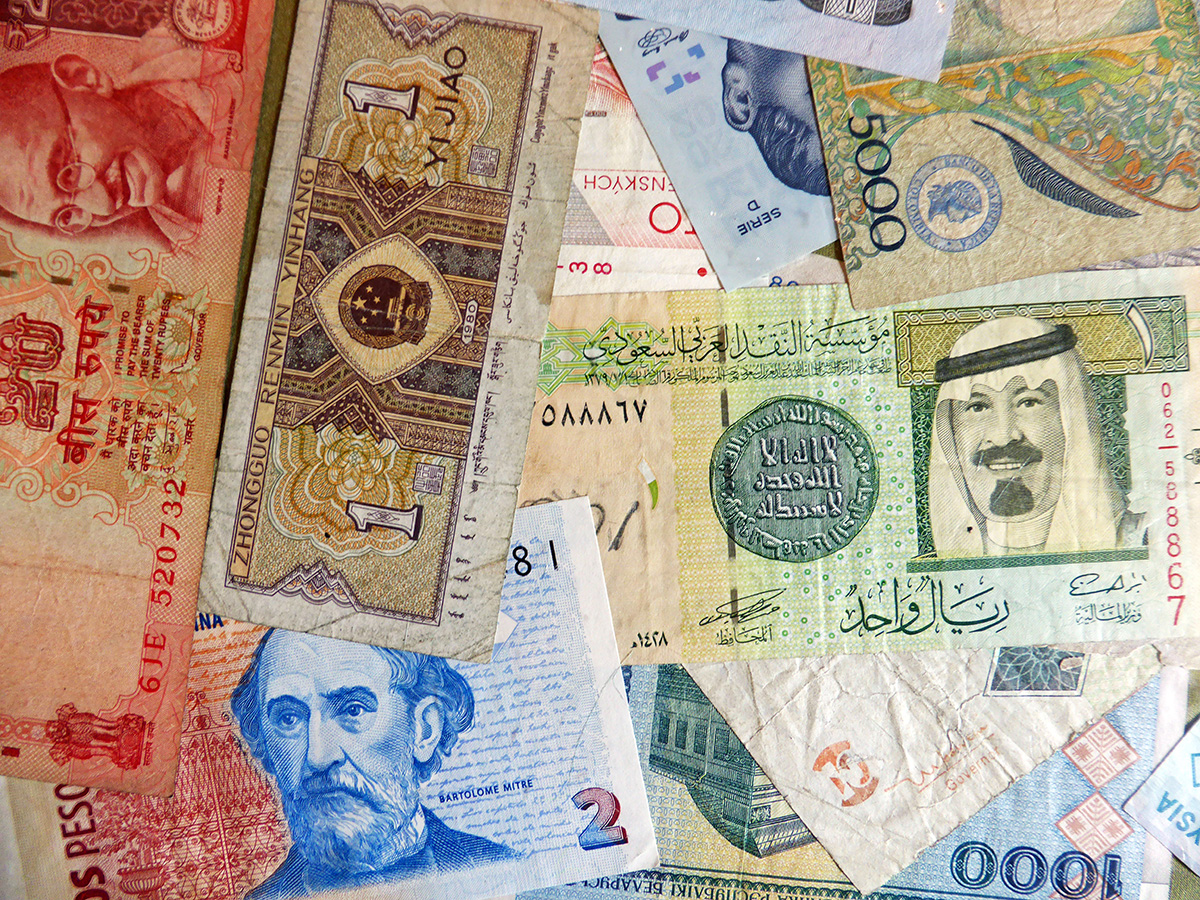 However, other monetary authorities worry that they have not yet earned the record of keeping inflation low and are concerned about the risk of wage inflation. In addition, in poorer countries there is a larger share of spending that goes on essentials such as food and energy. These have seen some of the highest price increases, so policy makers are going to be keen to stamp down on the inflation.
However, other monetary authorities worry that they have not yet earned the record of keeping inflation low and are concerned about the risk of wage inflation. In addition, in poorer countries there is a larger share of spending that goes on essentials such as food and energy. These have seen some of the highest price increases, so policy makers are going to be keen to stamp down on the inflation.
The Federal Reserve is expected to announce that it will start phasing out its $120bn monthly bond-buying programme (quantitative easing) as it confronts more pronounced price pressures and predictions that interest rates will be lifted next year. However, no adjustments are expected to be made to the Fed’s main policy rate, which is tethered near zero. Whilst financial markets are betting on an rise in Bank Rate by the Bank of England as early as next month, spurred by comments from Governor Andrew Bailey in mid-October that the central bank would ‘have to act’ to keep a lid on inflation.
Outlook for the UK
 The Bank of England’s Chief Economist, Huw Pill, has warned that high rates of inflation could last longer than expected, due to severe supply shortages and rising household energy bills. He said inflationary pressures were still likely to prove temporary and would fall back over time as the economy adjusted after disruption caused by COVID and Brexit. However, he warned there were growing risks that elevated levels of inflation could persist next year.
The Bank of England’s Chief Economist, Huw Pill, has warned that high rates of inflation could last longer than expected, due to severe supply shortages and rising household energy bills. He said inflationary pressures were still likely to prove temporary and would fall back over time as the economy adjusted after disruption caused by COVID and Brexit. However, he warned there were growing risks that elevated levels of inflation could persist next year.
The looming rise in borrowing costs for homeowners will add further pressure to family finances already stretched by higher energy bills and surging inflation. According to the Institute for Fiscal Studies, it is expected that households will face years of stagnating living standards, with predictions showing that households would on average be paying £3000 more each year in taxes by 2024/25, with the biggest impact felt by higher earners.
Investors are also reacting to concerns and have pulled $9.4bn out of UK-focused equity funds this year after hopes that a COVID-19 vaccination drive will fuel a vigorous economic recovery were overshadowed by questions about slow growth and high inflation. It is suggested that there is a general sense of caution about the UK when it comes to investing globally, driven by monetary, fiscal and trade uncertainties.
Given all the elements contributing to this outlook, The IMF has forecast that the UK will recover more slowly from the shocks of coronavirus than other G7 nations, with economic output in 2024 still 3 per cent below its pre-pandemic levels. Financial markets are predicting the Bank of England will lift interest rates as soon as the next MPC meeting. And while supply-chain bottlenecks and rising commodity prices are a global trend, the Bank’s hawkish stance has increased the possibility of a sharper slowdown in Britain than other developed markets, some analysts have said.
What next?
Some of the major central banks are poised to take centre stage when announcing their next monetary action, as it will reveal if they share the alarm about surging inflation that has gripped investors. Markets are betting that the Bank of England will begin raising interest rates, with Bank Rate expected to rise to around 1.25 per cent by the end of next year (from the current 0.1 per cent).
It is thought that the Fed will not raise interest rates just yet but will do so in the near future. Markets, businesses, and households globally will be waiting on the monetary decisions of all countries, as these decisions will shape the trajectory of the global economy over the next few years.
Articles
- Three Days Will Reveal Global Alert Level on Inflation: Eco Week
Bloomberg, Molly Smith and Craig Stirling (31/10/21)
- Inflation watch: Global food prices hit 10-year high
Al Jazeera (4/11/21)
- Fed sings the ‘transitory’ inflation refrain, unveils bond-buying ‘taper’
ReutersHoward Schneider and Ann Saphir (3/11/21)
- BoE chief economist warns UK inflation likely to hit 5%
Financial Times, Chris Giles (21/10/21)
- Inflation pressure now ‘brutal’ because of supply squeeze, US companies say
Financial Times, Andrew Edgecliffe-Johnson, Matthew Rocco, Obey Manayiti and Claire Bushey (23/10/21)
- Rising inflation could trigger global sell-off that would harm UK, says Bank
The Guardian, Richard Partington (8/10/21)
- Bank of England chief economist warns high inflation rates may persist in 2022
The Guardian, Richard Partington (7/10/21)
- Bank of England surprises markets by holding rates at record lows
CNBC, Elliot Smith (4/11/21)
 Bank of England resists pressure to raise interest rates as inflation spike looms
Bank of England resists pressure to raise interest rates as inflation spike loomsSky News, Ed Conway (4/11/21)
Forecasts and commentary
Questions
- What is the definition of inflation?
- How is inflation measured?
- Using a diagram to aid your answers, discuss the difference between cost-push and demand-pull inflation.
- What are the demand-side and cost-side causes of the current rising inflation?
- Explain the impact an increase in interest rates has on the economy.
 As we saw in Part 1, households are seeing a rise in the cost of living, which is set to accelerate. Inflation in the year to January 2022, as measured by the Consumer Prices Index (CPI), was 5.5%, the highest rate for over 30 years, and it is expected to reach more than 7 per cent by April. This has put great pressure on household budgets, with wage rises for most people being below the rate of price inflation. The poor especially have been hard hit, with many struggling to meet soaring energy, food and transport prices and higher rents.
As we saw in Part 1, households are seeing a rise in the cost of living, which is set to accelerate. Inflation in the year to January 2022, as measured by the Consumer Prices Index (CPI), was 5.5%, the highest rate for over 30 years, and it is expected to reach more than 7 per cent by April. This has put great pressure on household budgets, with wage rises for most people being below the rate of price inflation. The poor especially have been hard hit, with many struggling to meet soaring energy, food and transport prices and higher rents. The Chancellor, Rishi Sunak, has stated that the government understands the pressures families are facing with the cost of living. However, rising interest rates mean that it will cost the Treasury considerably more to service the UK’s national debt of more than £2tn.
The Chancellor, Rishi Sunak, has stated that the government understands the pressures families are facing with the cost of living. However, rising interest rates mean that it will cost the Treasury considerably more to service the UK’s national debt of more than £2tn. The Bank of England’s traditional response to rising inflation is to raise interest rates, which it has done this twice in the past few months. This means that people who have borrowed money could see their monthly payments go up, especially on mortgages tied to Bank Rate.
The Bank of England’s traditional response to rising inflation is to raise interest rates, which it has done this twice in the past few months. This means that people who have borrowed money could see their monthly payments go up, especially on mortgages tied to Bank Rate. Rising inflation affects all our living standards. It a global issue with causes beyond government control.
Rising inflation affects all our living standards. It a global issue with causes beyond government control.  What should the government do about rising energy prices?
What should the government do about rising energy prices? With the onset of the pandemic in early 2020, stock markets around the world fell dramatically, with many indices falling by 30% or more. In the USA, the Dow Jones fell by 37% and the Nasdaq fell by 30%. In the UK, the FTSE 100 fell by 33% and the FTSE 250 by 41%.
With the onset of the pandemic in early 2020, stock markets around the world fell dramatically, with many indices falling by 30% or more. In the USA, the Dow Jones fell by 37% and the Nasdaq fell by 30%. In the UK, the FTSE 100 fell by 33% and the FTSE 250 by 41%.
 The key question is what will investors believe. If they believe that share prices will continue to fall they are likely to sell. This has happened since early January, especially in the USA and especially with stocks in the high-tech sector – such stocks being heavily represented in the Nasdaq composite, a broad-based index that includes over 2500 of the equities listed on the Nasdaq stock exchange. From 3 January to 18 February the index fell from 15 833 to 13 548, a fall of 14.4%. But will this fall be seen as enough to reflect the current economic and financial climate. If so, it could fluctuate around this sort of level.
The key question is what will investors believe. If they believe that share prices will continue to fall they are likely to sell. This has happened since early January, especially in the USA and especially with stocks in the high-tech sector – such stocks being heavily represented in the Nasdaq composite, a broad-based index that includes over 2500 of the equities listed on the Nasdaq stock exchange. From 3 January to 18 February the index fell from 15 833 to 13 548, a fall of 14.4%. But will this fall be seen as enough to reflect the current economic and financial climate. If so, it could fluctuate around this sort of level. But a lot of this is second-guessing what other people will do – known as a
But a lot of this is second-guessing what other people will do – known as a  Inflation across the world has been rising. This has been caused by a rise in aggregate demand as the global economy has ‘bounced back’ from the pandemic, while supply-chain disruptions and tight labour markets constrain the ability of aggregate supply to respond to the rise in demand.
Inflation across the world has been rising. This has been caused by a rise in aggregate demand as the global economy has ‘bounced back’ from the pandemic, while supply-chain disruptions and tight labour markets constrain the ability of aggregate supply to respond to the rise in demand.  In the UK, annual CPI inflation
In the UK, annual CPI inflation  The Fed has signalled that it will end its bond buying (QE) programme in March 2022 and may well raise interest rates at the same time. Quantitative tightening may then follow. But although GDP growth is still strong in the USA, Fed policy and stretched household budgets could well see spending slow and growth fall. Stagflation is less likely in the USA than in the UK and many other countries, but there is still the danger of over-reaction by the Fed given the predicted fall in inflation.
The Fed has signalled that it will end its bond buying (QE) programme in March 2022 and may well raise interest rates at the same time. Quantitative tightening may then follow. But although GDP growth is still strong in the USA, Fed policy and stretched household budgets could well see spending slow and growth fall. Stagflation is less likely in the USA than in the UK and many other countries, but there is still the danger of over-reaction by the Fed given the predicted fall in inflation. Inflation has been rising around the world as a combination of a recovery in demand and supply-chain issues have resulted in aggregate demand exceeding aggregate supply. Annual consumer price inflation at the beginning of 2022 is around 2.5% in China, 3.5% in Sweden, 5% in the eurozone, Canada and India, 6% in the UK and South Africa, 7% in the USA and 7.5% in Mexico. In each case it is forecast to go a little higher before falling back again.
Inflation has been rising around the world as a combination of a recovery in demand and supply-chain issues have resulted in aggregate demand exceeding aggregate supply. Annual consumer price inflation at the beginning of 2022 is around 2.5% in China, 3.5% in Sweden, 5% in the eurozone, Canada and India, 6% in the UK and South Africa, 7% in the USA and 7.5% in Mexico. In each case it is forecast to go a little higher before falling back again. Why is Turkey’s inflation so much higher than in most developed and emerging economies and why has it risen so rapidly? The answer is that aggregate demand has been excessively boosted – well ahead of the ability of supply to respond. This has driven inflation expectations.
Why is Turkey’s inflation so much higher than in most developed and emerging economies and why has it risen so rapidly? The answer is that aggregate demand has been excessively boosted – well ahead of the ability of supply to respond. This has driven inflation expectations.
 Inflation has surged worldwide as countries have come out of their COVID-19 lockdowns. The increases in prices combined with
Inflation has surged worldwide as countries have come out of their COVID-19 lockdowns. The increases in prices combined with  Globally, rising inflation is causing concern as a surge in demand has been confronted by supply bottlenecks and rising prices of energy and raw materials. As the world emerges from the COVID-19 lockdowns, global financial markets have been affected in recent months by concerns around inflation. They have also been affected by the prospect of major central banks around the world being forced into the early removal of pandemic support measures, such as quantitative easing, before the economic recovery from the coronavirus is complete.
Globally, rising inflation is causing concern as a surge in demand has been confronted by supply bottlenecks and rising prices of energy and raw materials. As the world emerges from the COVID-19 lockdowns, global financial markets have been affected in recent months by concerns around inflation. They have also been affected by the prospect of major central banks around the world being forced into the early removal of pandemic support measures, such as quantitative easing, before the economic recovery from the coronavirus is complete. However, other monetary authorities worry that they have not yet earned the record of keeping inflation low and are concerned about the risk of wage inflation. In addition, in poorer countries there is a larger share of spending that goes on essentials such as food and energy. These have seen some of the highest price increases, so policy makers are going to be keen to stamp down on the inflation.
However, other monetary authorities worry that they have not yet earned the record of keeping inflation low and are concerned about the risk of wage inflation. In addition, in poorer countries there is a larger share of spending that goes on essentials such as food and energy. These have seen some of the highest price increases, so policy makers are going to be keen to stamp down on the inflation. The Bank of England’s Chief Economist, Huw Pill, has warned that high rates of inflation could last longer than expected, due to severe supply shortages and rising household energy bills. He said inflationary pressures were still likely to prove temporary and would fall back over time as the economy adjusted after disruption caused by COVID and Brexit. However, he warned there were growing risks that elevated levels of inflation could persist next year.
The Bank of England’s Chief Economist, Huw Pill, has warned that high rates of inflation could last longer than expected, due to severe supply shortages and rising household energy bills. He said inflationary pressures were still likely to prove temporary and would fall back over time as the economy adjusted after disruption caused by COVID and Brexit. However, he warned there were growing risks that elevated levels of inflation could persist next year.